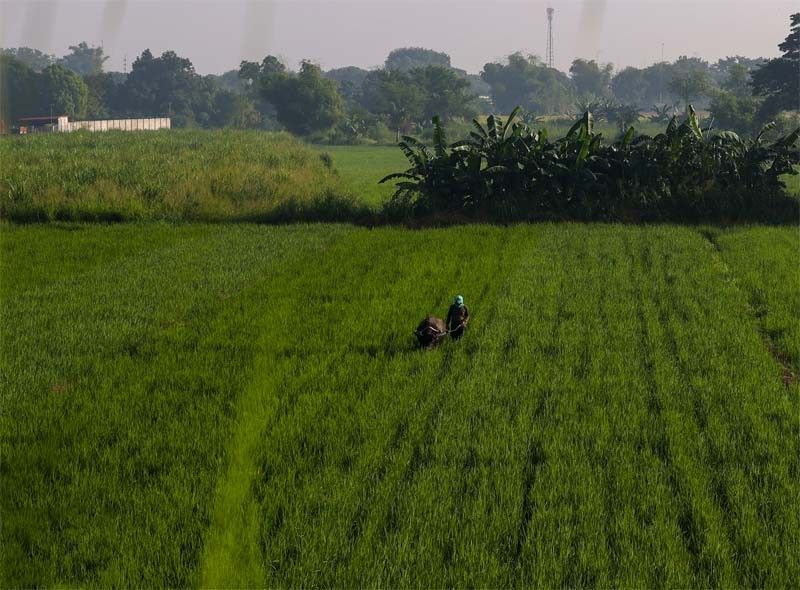Farmers benefitting from high palay prices – DA

MANILA, Philippines — Worldwide fears of a rice shortage triggered by the possible effects of El Niño are benefitting Filipino farmers as palay prices have increased because of tighter supply, the Department of Agriculture (DA) said yesterday.
“For the longest time, Filipino farmers have always been at the losing end of the rice sector. But now, Filipino rice farmers are enjoying better prices from their fresh harvest, perhaps sparked by global fears of a shortage resulting from the adverse impact of El Niño forcing world suppliers to tighten supply in the world market,” DA Undersecretary for rice industry development Leo Sebastian said in a statement issued by the Presidential Communications Office (PCO).
Palay prices reached P17.69 a kilo for fresh and P19.73 for dry in March, higher than the P15.99 for fresh and P18.41 for dry palay in the same period last year, according to the DA National Rice Program.
The following month, the price of fresh palay was at P17.66 per kilo while that of dry palay was P20.38, also higher than the April 2022 prices of P15.57 for fresh and P17.95 for dry.
The highest recorded palay prices were in Central Luzon at P22 for fresh palay and P25 for dry.
The agriculture department’s Regional Field Office 3 has reported that palay prices were at P20.46 for dry and P17.64 for fresh palay last April, higher than the P18.20 for dry palay and P15.67 for newly harvested grains in the same month in 2022. The office covers the province of Nueva Ecija, the Philippines’ rice granary.
Data from the Regional Field Office 2 showed that palay prices in March rose to P20.47 for dry and P16.52 for fresh palay, from P18.48 for dry and P15.1 for fresh in the same period last year.
Citing data from the Philippine Rice Industry Stakeholders Movement, the PCO statement said fresh and dry palay prices for the 2023 dry season were P18.50 and P22.50 in Isabela; P19.50 and P23.50 in Nueva Ecija; P20 and P24 in Bulacan; P18.50 and P22.50 in Tarlac and Pangasinan; P19 and P23 in Mindoro; P17.50 and P21.50 in Leyte; P19 and P23 in Caraga; P18 and P22 in Iloilo and P19.40 and P23.40 in Davao.
Nueva Ecija Rice Millers Association president Elizabeth Vana said retail prices of rice are expected to drop by at least P2 to P3 per kilo with the start of palay harvest.
She added that Nueva Vizcaya farmers were first to harvest, and will be followed by Cagayan, Isabela and Nueva Ecija.
For his part, Bongabon East Farmers and Fisheries Service Cooperative chairman Dan Alfaro said the harvest in Nueva Ecija would be delayed as many farmers were affected by the flooding brought by Typhoon Egay and the southwest monsoon.
Last week, President Marcos, also the agriculture secretary, said the Philippines’ rice supply is sufficient but prices are “very variable.”
He has ordered the DA and the trade department to closely monitor rice prices in the wake of reports that prices of the food staple are climbing to as high as P56 per kilo.
Importation
President Marcos should issue a categorical statement on whether he wants the National Food Authority (NFA) to import rice following a trip of officials of NFA and DA to India, farmers’ group Samahang Industriya ng Agrikultura (SINAG) said on Monday.
“We have talked to lawyers, and we will push through in hailing these officials to court if proven that they have been negotiating for rice imports,” SINAG executive director Jayson Cainglet said.
“We would rather hear from the President that he wants NFA to import rice. What we heard from the President is that there is no rice shortage and he wants the DA to increase local production. The DA officials have long been misquoting the President,” Cainglet added.
Meanwhile, rice watchdog group Bantay Bigas spokesperson Cathy Estavillo said the government should restore the powers of NFA so that it can directly buy palay from the farmers.
She added that NFA should resume the selling of P27 and P32 per kilo of subsidized rice.
Abolish NFA
Senators yesterday expressed mixed reactions on calls to abolish the NFA for heavily relying on rice imports over buying produce from local farmers.
Sen. Francis Escudero said he thinks their call for the abolition of the NFA is their way of saying that “it’s useless anyway, so why not just abolish it… I believe that what is really needed is to strengthen the power and capacity of the NFA to do its mandate.”
Escudero noted that “it is basically a statement that the NFA has become inutile and that government is simply relying on imports… without investing enough in agriculture with a view to increasing production and thereby providing food security for our country.”
Senate Minority Leader Aquilino Pimentel III said “if NFA is filling up its buffer stock with imported rice, then NFA has a lot of explaining to do.”
“And if NFA really turns out to be an agency that cannot fulfill its role, then I am open to the idea of abolishing it. Also in the meantime, the NFA should make sure that its stock, especially its oldest stock, is still fit for satisfying human consumption,” Pimentel noted.
Repeal
The Kilusang Magbubukid ng Pilipinas upheld their call for the immediate abandonment and repeal of the Rice Tariffication Law as they asserted that Marcos’ recent endorsement of reviewing the legislation is a “mere symbolic gesture aimed at pacifying the public amidst soaring rice prices.”
“The rice tariffication law, enacted under (former president Rodrigo Duterte) and pursued under Marcos Jr., wreaked havoc on the lives and livelihood of Filipino rice farmers and as it pushes further the domestic rice industry into decimation,” they said.
KMP secretary general Ronnie Manalo claimed that within the year of the law’s enactment, farmers suffered losses amounting to P85 billion, and within four years since its implementation resulted in about P265 billion in losses and a 40 percent reduction in rice farmers’ income. — Mark Ernest Villeza, Cecille Suerte Felipe
- Latest
- Trending































